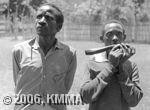





Other names: enkuri, eihembe, eikondere.
The amakondere and enzamba are conical traverse horns. Both instruments are described here together because they have striking similarities, the main difference being their function: the amakondere is the royal horn and the enzamba is a hunting horn. The enzamba is always made of animal horn and has a maximum length of 25 cm. Sometimes a rolled-up banana leaf is attached to the bell of the horn to strengthen the sound. The amakondere horn is always made up of two parts (gourd or animal horn and gourd) that are attached to each other with a piece of cow hide. The size of the amakondere can vary between 32 and 45 cm and is therefore larger than the enzamba. The diameter of the bell is not more than 8 cm.
Both instruments are slightly curved in shape and have a conical bore. The animal horn instruments are usually made of the horns of waterbuck, but bushbuck and reedbuck horns are also used. The mouthpiece is a small round or oval-shaped opening made in the side, 5 to 10 cm from the narrow end of the horn. The tip of the horn is cut off to make the opening. This opening can be covered to produce another note.
The mouthpiece is moistened with saliva before the instrument is played and the player has to keep his lips taut to achieve a good sound.
The enzamba hunting horn is always played solo and alternates with the ebiziniiriro, improvised narratives about the hunt and extraordinary feats that occurred during the hunt. The amakondere on the other hand is always played within an ensemble. The Ankole royal ensemble was made up of 9 amakondere players, rhythmically supported by the engalabi and engoma drums. The players were permanent court musicians, abakondere, who always came from the same families; it was considered an honour to be a court musician.
The enzamba is played at different times during the hunt, for instance when the hunters are called together for the hunt or as an expression of a successful hunt once the animal has been killed.
The amakondere were only played when the omugabe, the king of the Ankole, was present. The ensemble played mainly in the royal palace but also during wars and during festivities. The amakondere were played during battles in order to encourage the warriors; the rallying excitatory sounds reflected the power of the kingdom. It is unclear what remained of this tradition after the fall of the ancient Ankole kingdom.
for more information see also: VAN THIEL, Paul, "Multi-Tribal Music of Ankole. An ethnomusicological study including a glossary of musical terms." Edited by the Royal Museum for Central Africa, Annales, Sciences Humaines, nr 91, 1977, 234 pp.
© KMMA/Paul VAN THIEL